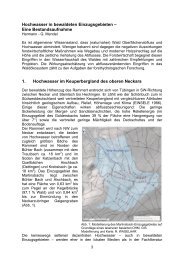PUCRS – P Bionomia de Monoeca xanthopyga Harter ... - EasyLit
PUCRS – P Bionomia de Monoeca xanthopyga Harter ... - EasyLit
PUCRS – P Bionomia de Monoeca xanthopyga Harter ... - EasyLit
You also want an ePaper? Increase the reach of your titles
YUMPU automatically turns print PDFs into web optimized ePapers that Google loves.
RODRIGO DA CUNHA <strong>PUCRS</strong> <strong>–</strong> PORTO ALEGRE<br />
DISSERTAÇÃO 2000<br />
<strong>Bionomia</strong> <strong>de</strong> <strong>Monoeca</strong> <strong>xanthopyga</strong> <strong>Harter</strong>-Marques, Cunha &<br />
Moure, 2001 (Hymenoptera; Apoi<strong>de</strong>a; Tapinotaspinini)<br />
no Planalto das Araucárias, Rio Gran<strong>de</strong> do sul, Brasil<br />
Resumo<br />
O estudo da bionomia da abelha solitária <strong>Monoeca</strong> <strong>xanthopyga</strong> <strong>Harter</strong>-Marques,<br />
Cunha & Moure, 2001, foi <strong>de</strong>senvolvido na região do Planalto das Araucárias, RS.<br />
Enfatizou-se a sazonalida<strong>de</strong>, o comportamento reprodutivo, as ativida<strong>de</strong>s das<br />
fêmeas durante a construção dos ninhos, os recursos florais utilizados e os<br />
parasitói<strong>de</strong>s associados. Três agregações <strong>de</strong> ninhos <strong>de</strong> M. <strong>xanthopyga</strong><br />
construídos em solo argiloso com cobertura vegetal esparsa ou ausente foram<br />
estudados no Parque Nacional dos Aparados da Serra, Cambará do Sul, RS. Os<br />
ninhos nestas agregações distribuíam-se irregularmente, em áreas <strong>de</strong> até 8 m 2 .<br />
A <strong>de</strong>nsida<strong>de</strong> máxima alcançada foi <strong>de</strong> 57 ninhos/m 2 . A única geração anual<br />
ocorreu entre janeiro e abril. Os imaturos permanecem em diapausa sob forma<br />
<strong>de</strong> pré-pupa durante 8 a 11 meses. Machos emergiram dos ninhos alguns dias<br />
antes das fêmeas e <strong>de</strong>sapareceram das áreas <strong>de</strong> agregações cerca <strong>de</strong> 4 semanas<br />
antes do termino das ativida<strong>de</strong>s das mesmas. A procura <strong>de</strong> fêmeas para o<br />
acasalamento ocorreu junto aos ninhos do ano anterior, on<strong>de</strong> vários machos<br />
disputavam as fêmeas emergentes. As cópulas duram em média 26 segundos e<br />
logo após o par separa-se. Fêmeas que construíam ninhos não eram atrativas<br />
aos machos. Porém, em testes <strong>de</strong> acasalamento em ambiente artificial observouse<br />
a ocorrência <strong>de</strong> cópula com fêmeas virgens e fecundadas. Após o<br />
acasalamento as fêmeas retornavam às agregações e fundavam ninhos a partir<br />
da escavação <strong>de</strong> novos túneis, ou em ninhos abandonados. As ativida<strong>de</strong>s <strong>de</strong> vôo<br />
das fêmeas iniciavam a partir das 6 horas e estendiam-se até próximo às 18<br />
horas. Realizavam, em média, 8 viagens diárias com duração média <strong>de</strong> 31,4<br />
minutos e retornavam com cargas <strong>de</strong> pólen e/ou óleos florais. Os recursos foram<br />
obtidos em flores <strong>de</strong> Malpighiaceae e Fabaceae. Políneas <strong>de</strong> orquí<strong>de</strong>as do gênero<br />
Oncidium eram transportadas aci<strong>de</strong>ntalmente a<strong>de</strong>ridas a cabeça <strong>de</strong> machos e<br />
fêmeas. Parasióoi<strong>de</strong>s mutilí<strong>de</strong>os estiveram presentes nas agregações <strong>de</strong> M.<br />
<strong>xanthopyga</strong> durante todo o período <strong>de</strong> ativida<strong>de</strong>s das abelhas. Uma espécie do<br />
gênero Traumatomutilla foi relacionada aos imaturos <strong>de</strong>stas abelhas,<br />
constituindo o primeiro registro <strong>de</strong> hospe<strong>de</strong>iro para este Mutillidae.<br />
da Cunha © http://www.pro-araucaria-online.com Seite 1
Abstract<br />
A study of the life history of the solitary bee <strong>Monoeca</strong> <strong>xanthopyga</strong> <strong>Harter</strong>-<br />
Marques, Cunha & Moure, 2001, was conducted at the Araucaria Plateau, at the<br />
state of Rio Gran<strong>de</strong> do Sul. The study focused the seasonally, sexual behavior,<br />
females activity during nest building, the exploited plant resources and the associated<br />
parasitoids. Three nest aggregations of M. <strong>xanthopyga</strong> built in clay soil<br />
with few plant cover or none at all, were studied on the Parque Nacional dos<br />
Aparados da Serra, located in Cambará do Sul, Rio Gran<strong>de</strong> do Sul State. The<br />
nests were randomly distributed in areas up to 8 square meters in size and reach<br />
at a maximum <strong>de</strong>nsity of 57 nests per square meter. The only one generation<br />
occurred from January to April. The immature stayed in diapausa in the prepupa<br />
stage during 8 to 11 months. Males emerged a few days before females, and disappeared<br />
from the aggregations four days before the end of females activities.<br />
The search for females to mate occurred at nests from the previous year, were<br />
many males struggled for a single emergent female. It is suggested that males<br />
perceive smells emitted by females. Copulation's lasted, on average, 26 seconds<br />
and, immediately after it, the couple separated. Nest building females were not<br />
attractive to males. Mating tests, at artificial environments showed the occurrence<br />
of copulation with both virgin and fertilized females. After mating, the females<br />
returned to the aggregations and established new nests by digging new<br />
tunnels, or by using abandoned nests. The bee's flying activities began around 6<br />
am and lasted up to 6 pm. The females did, on average, 8 trips per day, each<br />
one lasting 31,4 minutes. They returned from the trips carrying pollen and/or<br />
floral oils. These resources were obtained from flowers of Malpighiaceae and Fabaceae<br />
species. Pollinaria from orchids of the genus Oncidium were carried acci<strong>de</strong>ntally<br />
by males and females. Mutilid parasitoids were present at the aggregations<br />
of M. <strong>xanthopyga</strong> during all the period of the activities. One species of<br />
Traumatomutilla as related to the immature of these bees, composing the first<br />
registration of inhabitant of this Mutillidae.<br />
da Cunha © http://www.pro-araucaria-online.com Seite 2



